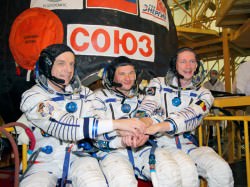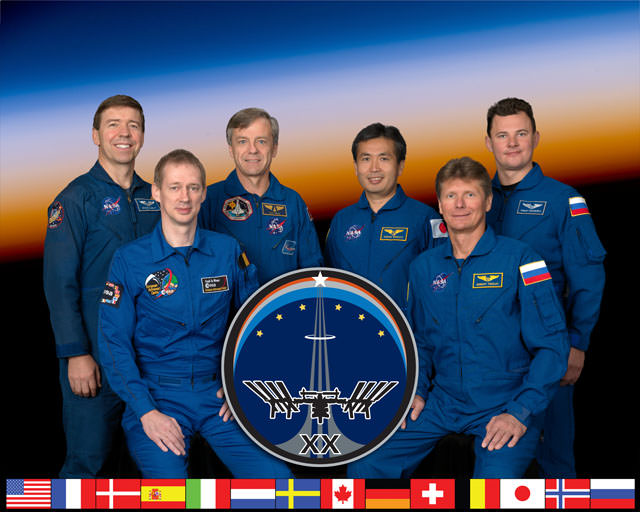[/caption]
Three astronauts set to launch on a Soyuz rocket will bring a new era to the International Space Station by doubling the permanent crew size. Also, for the first time all the ISS partners will be represented on board the station at once as astronauts from NASA, CSA, ESA, JAXA and Russia will be part of the first six-person permanent crew. Liftoff is scheduled for 4:34 p.m. local time (1034 GMT; 0634 EDT) Wednesday from Russia’s Baikonur cosmodrome in Kazakhstan. The Soyuz TMA-15 capsule is expected to dock with the space station about two days later.
On board the Soyuz will be a truly international contingent, with Canadian astronaut Bob Thirsk, Russian cosmonaut Roman Romanenko, and Belgium’s Frank De Winne. They will join the current crew of the orbiting laboratory: Russia’s Gennady Padalka, U.S. astronaut Michael Barratt and Japan’s Koichi Wakata.
Thirsk called the expansion from a three-person to a six-person crew a “milestone” and said one of their goals was “to prove the station can support six people for a long duration.”

“This is the most international crew we’ve ever had” said Courtenay McMillan, Expedition 20 lead flight director. “It opens up a lot more possibilities and lets us schedule more science. We also have a lot more maintenance activities that can be done. Having six people on board does present a bit of challenge in communications with the ground, as we have twice as many people but no more ‘phone lines’, but folks are getting creative. We’ve learned a lot from the handover periods.”
A current crew of three typically has only about 20 hours a week to devote to science, but with six crew members, ISS officials hope to nearly triple the amount of time spent on science experiments. “This is a big transition from where we have been short on time. Now we have time,” said McMillan. “The crew has been very active in working with science community, ground control teams and to take advantage of the time we have.” McMillan added that the crew will have the ability to do not just new science, but doing additional runs on science that is up on board the station now.”
The last few shuttle missions to the ISS and Progress re-supply ships have been bringing up enough supplies to accommodate the increase in crew size. Now that the urine recycling system is working well, food is the biggest consumable the crews have had to stockpile.
“We have good margins on consumables,” said McMillan. ” We’ve piled up more margin than we usually do, to protect against flight slips. NASA said there is enough supplies on board that the crew could have enough to eat though October, even if no shuttles or Russian ships made it to the station. However two shuttle missions and two Soyuz capsules are scheduled to arrive at the station before the end of October.


NASA TV plans live coverage of both the launch on Wednesday morning and the Friday morning docking and hatch opening. See the NASA TV schedule for times here: http://www.nasa.gov/multimedia/nasatv/MM_NTV_Breaking.html . It’s quite striking to see the difference in protocol of pre-launch proceeding vs. a Shuttle launch. (Check out the cosmonauts reactions to getting sprinkled with holy water just before suiting up!) And the Soviet launches usually include live footage of the cosmonauts during ascent, compared to NASA usually releasing internal ascent footage well after the Shuttle is in orbit. On the whole, I find it just as exciting as watching Shuttle launches and ISS dockings.
After the exceptional positive impact of manned space flight in the Hubble service mission, we now get the opposite. I have a hard time thinking of any real scientific value of the ISS.
Thanks for this, I’ve seen very little coverage of the “new era”. (They fixed the urine recycling? Wonder if it is the same contraption or a new one.)
Lawrence, I seem to remember BA listing all the science done at the ISS. It was an impressive list despite having a 0.5 science week (really, 0.25, considering the usual worked hours).
Figures, since if we are generous with the above estimation they have since 2000 had 4.5 years worth of science on place, not considering the auxiliary work around it. That would be quite a few papers.
BA = Bad Astronomer blog, of course. But correcting this, I’m not so sure it was him anymore.
Btw, this topic would make a good article. But if it never surfaces, one would hope that a book about ISS would cover the topic.
It would be interesting, since there are science that AFAIU can’t be done anywhere else. I tend to see it as a specific facility like WMAP, albeit not with anything terribly exciting for me personally.
Oh, well. “Science trek, preferably to boldly go where no man has gone before, otherwise to repeat the darn thing.”